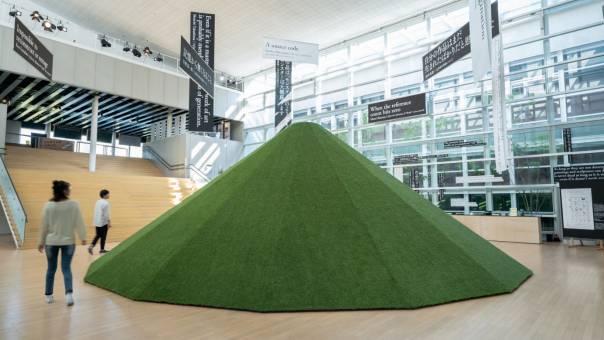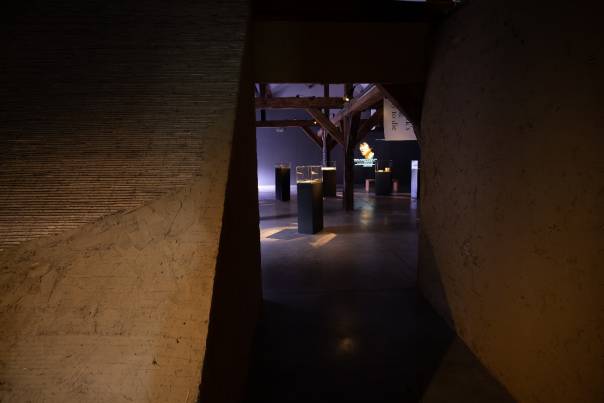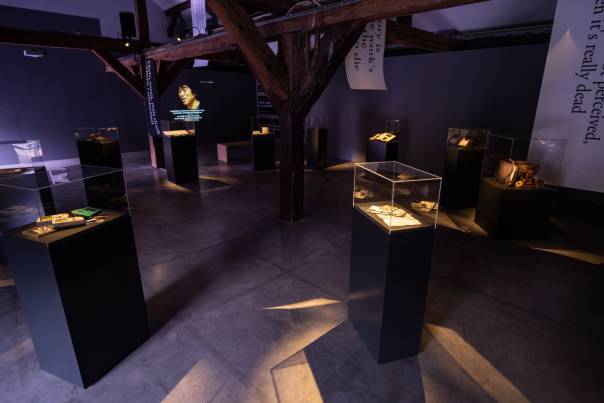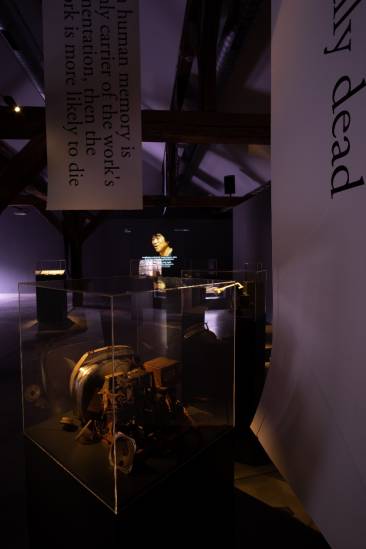This is an old revision of the document!
Dead Artworks as Narrators: (Re)use of Broken Artworks in the Media Art Narrative at the Exhibition //Reincarnation of Media Art// in WRO Art Center in Wrocław (2019)
Introduction
Perhaps the perspective of protecting works of art should shift from thinking about extending life – to ‘being to death’ in order to benefit from them as much as possible. The quoted idea is the conclusion of one of the Getty Conservation Institute specialist panels on changes and developments in the field of modern art conservation (2008)1). This paper delivers commentary and analysis on 'dead artworks’, although the research is limited to media art, which, despite their youth, often die first. The topic is discussed in the example Reincarnation of Media Art exhibition curated by Agnieszka Kubicka-Dzieduszycka in WRO Art Center in Wrocław (2019)2) – a Polish iteration of the concept, by the Japanese artist group exonemo, of Mausoleum of Media Art realized at YCAM, the Yamaguchi Center for Arts and Media (2018)3).
The pages that follow will provide an overview of the current debate over the death of works of modern art, including media art. Then, in the context of various conservation approaches and artistic paradigms, the forms of its protection will be briefly listed, as well as the sources of broken artworks. A contemporary critical view on forcible preservation, over-archiving, and large quantities of artifacts in warehouses will be presented using a conservatory perspective of research. The following chapter demonstrates how to use broken artworks in a narrative of media art history. The final section contains research on an attempt to systematize and name the objects discussed in the paper.
The debate about death
Fig. 1. Reincarnation of Media Art exhibition in YCAM Japan.
The twentieth century is characterized by new paradigms, and significant changes in the field of art, which impacted not only art recipients but also critics, curators, and conservators. Art protection is complicated, so defining art, as well as deciding what to keep and at what price, became difficult. Modern art is rapidly degrading due to fragile elements, experimental techniques, and unstable new materials. As a result, we frequently come across dead artworks that are the result of an experiment or assumptions, which have been damaged in transit or are mechanically broken. Richard Rinehart lists three ways for art to die in the context of media art: death by technology, death by institution, and death by law4) She emphasizes that keeping media art in use is the best prevention strategy. Those complicated by their media's temporal nature artworks have a potential for ‘emulation, migration, and re-interpretation' according to Hanna B. Hölling5). The identity of media art is dispersed throughout various objects, processes, and contexts, and the death of art becomes a topic of debate due to the potential volatility of media. This variability is strongly intertwined with the extensive documentation of the work, which in some cases becomes part of the artwork.6)
Art conservators discuss the death of art, but more in the context of avoiding rather than accepting it. The theme of art mortality was presented at the conference in the field of modern art restoration Mortality Immortality? (1998)7), followed by another organized by Getty Conservation Institute (2008)8), and at the last INCCA panel titled Death of an Artwork (2022)9). Rosario Llamas-Pacheco recently summarized this issue, identifying the death of art with its disappearance, despite the fact that the causes of art's death vary: from natural degradation to an accident to an intentional artistic approach10). Following Mario Sousa's death paradigm, Llamas-Pacheco proposes an attitude of accepting the death of a work not only of its matter but also of its concept11). Regardless of the causes of death, collections deal with damaged works, their broken or replaced parts that do not represent a work of art but are replaceable elements.
Despite preventative conservation, artworks lose parts, have replaced mechanisms, and occasionally lose their meaning. As in the case of Joseph Beuys, whose Felt Suit (1970) is suspended in conceptual and physical limbo in the Tate Collection after being eaten by moths.12) Another example, Nam June Paik's artworks are the best illustration of the existence of replaceable parts while also being closely related to art with rapidly aging technology, as seen in the review of TV Garden (1974).13) Assuming artist awareness, the best preventive plan, and tracking the technology's adoption curve, we must consider that some technical elements will break and require replacement – but what about the originals?
Reincarnation of Media Art
Fig. 2. Reincarnation of Media Art exhibition in Wro Art Center in Wrocław. Photo: Zbigniew Kupisz. Courtesy of WRO Art Center.
The original concept of a Mausoleum of Media Art came from the artist Kensuke Sembo, during a discussion on media art conservation between the exonemo group and the YCAM curators. Together with Masaki Fujihata they invited artists to ‘consider the death of artworks and the possibilities for reincarnating them in the future’14). The exhibition's visitors explored relics and documentation of time-based art in the mausoleum inside YCAM's main building. The audioguide was used to guide visitors through the exposition of relicts of media art, which started with a presentation 'death of a work' of Nam June Paik's CRT monitors from Video Chandelier No.1 (1989).
Fig. 3. Reincarnation of Media Art exhibition in WRO Art Center in Wrocław. Photo: Zbigniew Kupisz. Courtesy of WRO Art Center.
Fig. 4. Reincarnation of Media Art exhibition in WRO Art Center in Wrocław. Photo: Zbigniew Kupisz. Courtesy of WRO Art Center.
The Polish iteration of Reincarnation of Media Art was created as part of the 18th Media Art Biennale WRO at WRO Art Center (2019), a pioneering festival and institution in Poland that has been dealing with the promotion, production, and documentation of media art for the past 30 years. Agnieszka Kubicka-Dzieduszycka curated the exhibition, and the works on display were chosen in collaboration with other WRO team members. In that case, a synthetic voice guide leads visitors around the mausoleum, referring only to the tomb with the entrance (Fig. 2), and tells them about the causes of death of the works displayed in the crypts – plexiglass cubes on pedestals (Fig. 3). The audio guide was played on old portable devices like a radio cassette player or a portable CD player.
WRO Art Center showed dead works of eight artists collaborating with WRO and YCAM, including the repeated hommage to the 'father of media art': the exhibition in Wrocław also started with Nam June Paik, displaying in this case the innards of a broken CRT monitor from Zen for TV (1963), and U-Matic cassette (1980s). Works by other artists followed: mobile phone used in Rafael Lozano-Hemmer's performance – Hemmer Amodal Suspension (2003); hard disk with data of Web Hopper (1996) by Koichiro Eto; YMO Techno Badge (1980) by Masaki Fujihata; old iPhones with Nao Tokui's applications (2008); VHS tapes with performance Ucieleśnianie [Embodyiment] (1994) by Piotr Wyrzykowski; VHS with Performans na żądanie [Performance on Request] (2001) by Anna Płotnicka and Paweł Janicki; broken gaming consoles of the Gameboyzz Orchestra Project (2001); broken floppy disks of Łukasz Szałankiewicz aka Zenial, and an actual sound release on a floppy disk by the artist (1996-2019).
The exhibition in Wrocław was an example of various conservation strategies or a relic of dead artworks. Preservation by documentation, which was developed for time-based art protection, can be applied to the performances of Lozano-Hemmer, Płotnicka&Janicki. The light show's photo album additionally focuses on audience memories. The artworks are also represented by technology, such as telephones, placing them in the historical context. The VHS tapes on display can be viewed as either documentation – a recording of Płotnicka's performance (2001) – or as an artifact used by Wyrzykowski in a creative act (1994). As Sylwia Szykowna points out, it has a different meaning and example of object memory, where those items are tangible intermediaries between historical events.15) Broken hard disks or floppy disks (Koichiro Eto) can also be used as a form of mediation. Nam June Paik's TV, on the other hand, best exemplifies the most important aspect of media art: variability and its implications for the maintenance strategy.
This conservation paradigm constructed by Variable Media Network refers to practices aimed at maintaining certain parameters of work stability, transforming artwork, but in accordance with the intention of its creator.16) Another approach is 'changeability,' a concept introduced by Hölling that refers to the possibility of changing one artwork into another, transforming conservation into art continuation rather than conservation.17) While part of the work, Nam June Paik's TV carries at least one Llamas-Pacheco listed value of ruin-relic that deserves preservation: cultural, intentional, historical, or iconic type.18) Furthermore, the artist's signature on the TV with the number 4/12 resembles a Duchamp gesture and designates a one-of-a-kind work.19)
In addition to the exhibition, Reincarnation of Media Art is also a research platform, with a set of three questions raised to artists about the future of their works. The results of the surveys, as well as artists' awareness of the protection of their works, are particularly interesting for conservators. This awareness is the topic for a separate study, but it should be mentioned in light of Rafael Lozano-Hemmer's presence, who promotes Best Practices for Conservation of Media Art from an Artist's Perspective.20)
To summarize surveys included in the Japanese exhibition: YCAM received 41 responses to a total of 124 questionnaires, four of which were made public on the project's website. 'Who on earth would want to participate in a show like this? […] I don't want to see my works in a tomb,'21) Masaki Fujihata responded to Kensuke Sembo's proposal to create an exhibition that looks like an ancient burial. Fujihata was eventually persuaded, and some other artists provided responses to the questions, ranging from outright rejection of the work's materiality (Kyle McDonald) to meticulous planning and documentation of the work (Akos Maroy). Yap Sau Bin wrote about re-mediation – a type of preservation – in the sense of 'analog→ digital→ analog’ 22) which corresponds with Jussi Parikka's media archeology.23)
In the Polish iteration of the project, video interviews with the artists invited to the exhibition were recorded and displayed at WRO Art Center and its online platforms. Among the video and quotes shown in Wrocław, one slogan stood out: 'A dead work is a forgotten work' according to Zenial; thus, artists do not want to be forgotten. It must be added that media artists, through the observation of new rapidly changing technologies, are one of the most technique-conscious creators. To summarize, the Reincarnation of Media Art project not only demonstrated preservation approaches, but also the artists' attitudes and raised preservation awareness, not to forget Nam June Paik’s consideration ‘My TV is not always interesting, but not always uninteresting.’24)
Dead artworks
The focus of this thesis was to evaluate the worth of the items on display at the Reincarnation of Media Arts exhibition. The most common noun used to describe displayed objects was 'dead artworks,' because the mausoleum's founders used the concept of death. In the examination of the Wrocław show, Szykowna refers to the exhibits as ‘relics’ and ‘material remains.’25) Kensuke Sembo, one of the Japanese proposal's authors, used more direct phrase 'corpses’. The term ‘ruin-relic’ also defines Llamas-Pacheco as: ‘the state in which the artwork, after the passage of time, […] has reached a point at which it is no longer capable of facilitating the entity’s experimentation’.26)
Consequently, the objects should be preserved despite their poor condition or loss of integrity because they reflect other cultural values and serve as historical witnesses. If one accepts Janina Hoth's definition, such witnesses could be represented by photographs of performances presented at the Reincarnation of Media Art exhibition. She characterizes the dominant witnesses of historical knowledge despite the fact that they are merely ‘mediators of a specific point of view.’27) These documents cannot be recorded in their current form due to their media coverage, according to Hoth, but should be re-edited by conservators / archivists and again by observers.28)
In this context, the most challenging is the readymade and Fluxus movement, in which the document or its copy becomes a piece of art, as Filipovic describes using Marcel Duchamp's notes as an example.29) As a result, it's tricky to come up with a clear definition of art documentation, which could be useful in determining an object's status. As marked by Aga Wielocha along with the expansion by Fluxus of the field of art on happenings, actions, and events 'the distinction between artwork and documentation began to blur.'30)
Each action and performance leaves material traces in the form of documentation, as well as tangible artifacts, and inanimate actors in the performance, which are archived and displayed during exhibitions. Those objects are crucial in the preservation of performative art since they are unused and inactive but are kept for their aesthetic and sculptural value.31) When the artist modifies the display equipment to the point that it becomes a sculptural piece, as stated by Laurenson, ‘its significance conforms more readily to that of a traditional museum object.’32)
In an interview on dead artworks in the Tate collection, Patricia Falcao describes such things as 'dedicated equipment', and points out that the conservation path would be different in that case, carried out by the sculpture conservation department.33) As a result, such 'archived objects' are preserved and monitored in a controlled environment alongside the rest of the collection, similar to Felt Suit storage, where the excavated archeological relic retains the essence of its 'raison d'être, but no longer functions as such.'34)
Wielocha proposes that artifacts, or actual components of artworks, can be regarded as documentation of artistic practice.35) The ‘archival turn’ was already postulated by Hölling, analyzing media art, she suggested that a work of art could become an archive of itself.36) If we accept all physical changes to material works, every trace of time will be subject to future inquiry, therefore instead of showcasing the patina, we should do the opposite, Rinehart recommended37). However, the preservation of each element is difficult due to storage limitations and environmental sustainability.
In the case of media art, which usually contains electronic, partially replaceable pieces this method can be challenging. Hoth has similar reservations, and she questions the purpose of keeping relics, arguing that if an artificial relic market isn't working against the artist?38). One of the arguments for preserving such a collection is that it is actively used. Annet Dekker defines digital archive as its ‘re-use instead of storage, circulation rather than centrally organized memory’39), and uses ‘artifacts’ to describe both items and documentation. She adds in the essay that the archive allows for fresh interpretations of art40), therefore preserving the memory and the life of the artwork.
Conclusion
Artworks have been constantly reinterpreted and transformed throughout history. This variability is especially prevalent in media art artifacts, and it has an impact on the alternative modes of conservation discussed in the paper and observable at the examined exhibition. Broken artworks on pedestals were taken, among other things, from private archives and institutional warehouses. Thus, Reincarnation of Media Art curated by Kubicka-Dzieduszycka and the WRO Art Center team, was an example of active, generative archive management, as described by Dekker.41)
Art objects used as new methods of documentation can create a ‘different process of knowledge cognition.’42) Barker and Bracker emphasize the need of demonstrating the possibility that inanimate items continue to resonate in museums or collections after their death.43) Returning to the idea stated in the paper's title, Reincarnation of Media Art example illustrated that using dead artwork as narrators of the history of media art extends the life of the art and supports its preservation.



